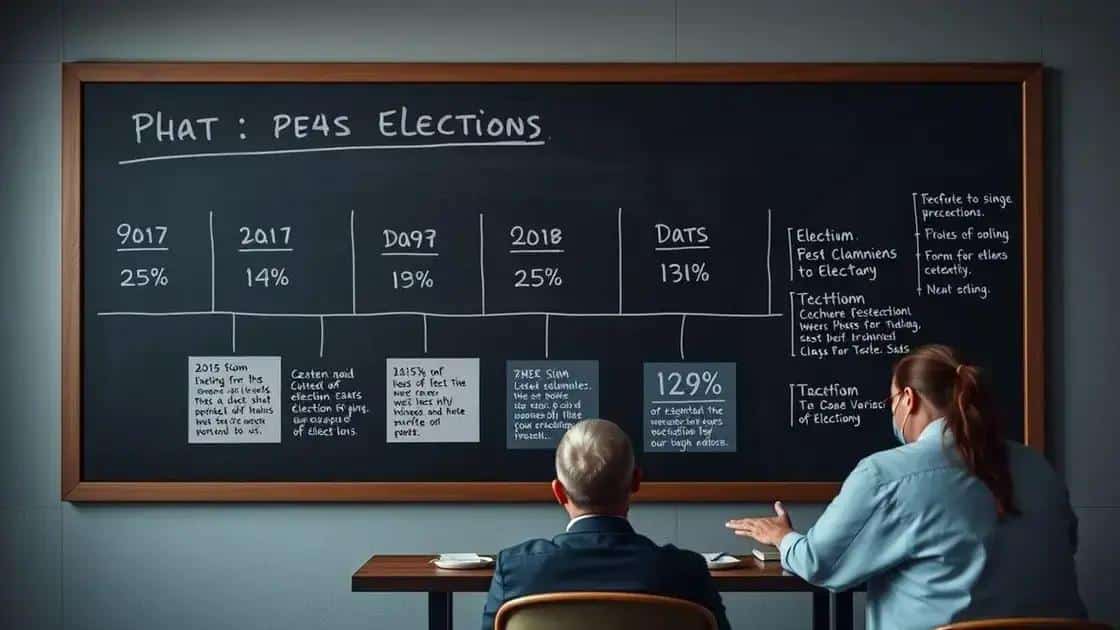Election analysis: uncovering trends in voter behavior

Election analysis reveals that historical data and demographic trends significantly influence voter behavior and campaign strategies, particularly in swing states where electoral outcomes are often decided.
Election analysis is crucial in understanding how voters make decisions. Have you ever wondered what really drives people to the polls? In this article, we’ll delve into the dynamics shaping electoral outcomes.
Understanding the role of demographics in elections
Understanding the role of demographics in elections is vital for grasping how different groups of people influence outcomes. Each election reveals trends that can shape future political landscapes, and demographics often hold the key to these patterns.
Age, gender, and ethnicity are three primary demographic factors that can sway voting behavior significantly. For instance, younger voters tend to lean towards progressive policies while older generations may favor more traditional approaches. This difference underscores the importance of getting to know who your audience is during campaigns.
Key Demographic Factors Influencing Elections
Numerous factors come into play when analyzing how demographics affect voting patterns. Some of the more notable ones include:
- Income levels: Higher income often correlates with different political priorities.
- Education: More educated individuals may vote differently than those with less formal education.
- Geographic location: Urban versus rural divides can impact political ideologies.
- Race and ethnicity: Different ethnic groups often align with specific parties based on cultural values.
The politically active youth demographic has shown to influence elections in recent years. With their heightened awareness of issues such as climate change and social justice, they are becoming a force to reckon with. This fact emphasizes that candidates must address their concerns, or risk losing support from this critical voting block.
Furthermore, analyzing voting trends among women and people of color reveals that these groups are increasingly pivotal in shaping electoral outcomes. Candidates who engage with these demographics effectively can harness a significant advantage, ensuring their message resonates with a wider audience.
As elections approach, understanding these demographic shifts becomes more critical. Analyzing past data helps predict future trends, allowing political parties to strategize their campaigns thoughtfully. By recognizing these influences, aspiring leaders can connect more authentically with their constituents.
The impact of social media on voter engagement

The impact of social media on voter engagement has transformed how people interact with political campaigns. With platforms like Twitter, Facebook, and Instagram, voters can access information quickly and express their opinions freely.
Political campaigns leverage social media to reach a broader audience. Candidates can share their messages directly with voters, cutting out traditional media’s gatekeeping role. This direct line of communication has reshaped the electoral landscape, making voter engagement more accessible than ever.
Key Influences of Social Media
Several key aspects illustrate how social media affects voter engagement:
- Real-time information: Voters receive updates about candidates and policies instantly.
- Community building: Social media fosters connections among like-minded individuals, creating a sense of belonging.
- Increased mobilization: Campaigns can easily organize events and encourage participation through shares and invites.
- Viral content: Engaging posts can go viral, amplifying a candidate’s reach and influence.
Furthermore, social media can also lead to echo chambers, where voters are exposed mainly to information that aligns with their views. This phenomenon might contribute to polarized opinions, influencing voter behavior. Candidates must be aware of this and strive for balanced discourse while campaigning.
During elections, social media also plays a crucial role in fact-checking and misinformation combating. Voters are more equipped to verify claims made by candidates, which can enhance the democratic process by promoting informed decision-making.
In summary, social media has a profound effect on how voters engage with the political system. Understanding its dynamics is essential for candidates seeking to connect with the electorate effectively. By adapting to these platforms, politicians can maximize their outreach and drive higher voter participation.
Analyzing swing states and their significance
Analyzing swing states and their significance is crucial for understanding electoral outcomes in the United States. Swing states are those that do not consistently vote for one party and can be won by either Democrats or Republicans in different elections.
These states often hold the key to winning an election. For candidates, focusing on swing states means maximizing their chances of capturing important electoral votes. This understanding leads to competitive campaigns and targeted messaging that resonates with the local voters.
Key Characteristics of Swing States
Swing states possess certain characteristics that make them pivotal during elections:
- Voter Demographics: A diverse mix of populations can lead to unpredictable voting patterns.
- Political Culture: Local issues and state sentiments can significantly influence voter preferences.
- Historic Voting Trends: Analysis of past elections can reveal shifts in political alignment over time.
- Economic Factors: Economic conditions, such as unemployment rates, can sway voters in crucial moments.
In the last elections, states like Florida, Pennsylvania, and Wisconsin proved their importance once again. Candidates who can connect with the issues impacting voters in these regions tend to perform better. This focus allows them to create personalized campaign strategies that address specific local concerns, such as healthcare, education, and job creation.
Moreover, the impact of swing states extends beyond just winning the presidency. Outcomes in these states can shape congressional races and influence local politics. For instance, if a candidate wins a swing state, it can boost their party’s chances in down-ballot races across the state.
Understanding swing states is a dynamic process. Campaigns often adapt their strategies based on the latest polls and voter sentiment. As the political landscape evolves, so too do the states that are considered “in play,” making it essential for candidates to remain agile and informed.
How historical data influences current elections

How historical data influences current elections is a critical aspect of political strategy. By examining past electoral outcomes, candidates and analysts can identify trends that may repeat in future races. This analysis helps in understanding voter behavior and preferences over time.
Election history is filled with valuable insights. For instance, examining voting patterns in past elections reveals how certain demographics voted. Candidates can learn which issues resonated with voters, helping them craft messages that appeal to the electorate today.
Key Aspects of Historical Data Analysis
Several factors of historical data can significantly impact ongoing elections:
- Voter Turnout Trends: Understanding which groups historically turn out to vote helps predict future engagement.
- Previous Election Results: Analyzing wins and losses in specific regions can guide campaign strategies.
- Demographic Shifts: Changes in population demographics can alter political landscapes, highlighting new target audiences.
- Major Events Impact: Historical events that shaped previous elections often influence current voter sentiments.
For example, if a region showed a significant turnout among younger voters in past elections, candidates might focus their messages on issues like education and jobs to attract those voters. Additionally, the impact of significant events, such as economic crises or social movements, continues to shape the political landscape.
Furthermore, data from past elections can inform campaign strategies. Candidates might look at voter preferences for particular policies and tailor their platforms accordingly. This targeted approach can maximize appeal and engagement among potential voters.
Ultimately, understanding how historical data shapes current elections is essential for candidates who wish to connect effectively with voters. By leveraging past insights, campaigns can devise strategies that resonate well in today’s complex political environment.
FAQ – Frequently Asked Questions about Election Analysis
What are swing states and why are they important?
Swing states are areas where both major political parties have similar levels of support, making them critical for winning elections.
How does historical data influence current elections?
Historical data helps candidates understand past voter behavior and tailor their strategies to connect with voters more effectively.
What role does social media play in voter engagement?
Social media allows candidates to communicate directly with voters, share their messages quickly, and mobilize supporters efficiently.
Why is understanding demographics important in elections?
Demographics provide insights into various voter groups, helping candidates craft messages that resonate with different segments of the population.






